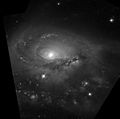Top Qs
Timeline
Chat
Perspective
NGC 1961
Galaxy in the constellation Camelopardalis From Wikipedia, the free encyclopedia
Remove ads
NGC 1961 is a spiral galaxy in the constellation Camelopardalis. It was discovered by German-British astronomer William Herschel on 3 December 1788.[2] It was also observed by Guillaume Bigourdan on 22 December 1891, causing it to be listed in the Index Catalogue as IC 2133.[2] Its velocity with respect to the cosmic microwave background for is 3,909±2 km/s, which corresponds to a Hubble distance of 188.0 ± 13.2 Mly (57.65 ± 4.04 Mpc).[1] However, seven non redshift measurements give a much closer distance of 145.42 ± 27.36 Mly (44.586 ± 8.390 Mpc).[3]
The galaxy has been distorted, however no companion has been detected nor double nuclei that could show a recent merger. Its outer arms are highly irregular. Two long straight arms extend from the north side of the galaxy.[4] A luminous X-ray corona has been detected around the galaxy.[5][6] NGC 1961 is the central member of the small group of nine galaxies, the NGC 1961 group.[4]
Remove ads
Supernovae
Four supernovae have been observed in NGC 1961:
- SN 1998eb (Type Ia, mag. 17.8) was discovered by the Lick Observatory Supernova Search (LOSS) on 17 August 1998.[7][8]
- SN 2001is (Type Ib, mag. 17.6) was discovered by BAO and LOTOSS (Lick Observatory and Tenagra Observatory Supernova Searches) on 22 December 2001.[9][10]
- SN 2013cc (Type II, mag. 17) was discovered by Kōichi Itagaki on 28 April 2013.[11][12]
- SN 2021vaz (Type II, mag. 17.5) was discovered by Kōichi Itagaki on 5 August 2021.[13][14]
Remove ads
Gallery
- NGC 1961 by GALEX
- NGC 1961 by Mount Lemmon Observatory
- NGC 1961 by DSS
- NGC 1961 by Hubble Space Telescope
References
External links
Wikiwand - on
Seamless Wikipedia browsing. On steroids.
Remove ads





